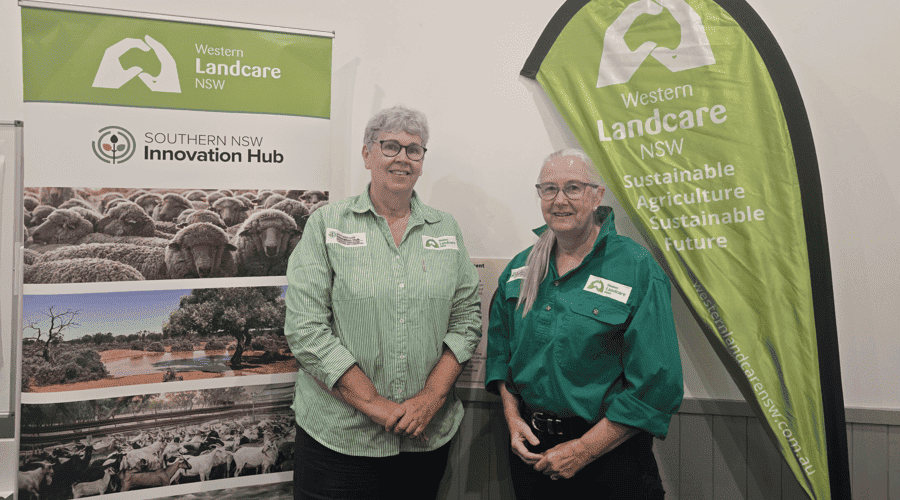Download the case study
Background
Embedded in trusted partner organisations across the region, Southern NSW Innovation Hub Knowledge Brokers provide valuable information, ideas, and insights to farmers, landholders, and communities.
Based in Broken Hill with Western Landcare NSW, two Knowledge Brokers Diana Anderson and Mary Anne Watson, supported NSW’s most remote region, engaging directly with locals to identify needs and enhance drought resilience.
Unique combination of remoteness and diversity
The semi-arid Western Rangelands span 160,000 square kilometres – nearly twice the size of Panama or Ireland. For Diana and Mary Anne, this vast area was “their patch” with travel times of up to nine hours from one end to the other. Drought and dry periods are part of the region’s climate, and the daily challenges only strengthened their motivation.
Diana said, “That includes connectivity issues, road closures and dirt roads that at times aren’t navigable, flood events and dry times at different ends of the region simultaneously. It was all part of the job in connecting with locals to share information, ideas and insights to enhance drought resilience.”
Mary Anne added, “What’s also unique to this region is the variety of land use, of people and of geography. We go from down in Balranald, where there is cropping, horticulture and viticulture along the river, properties that are organic, some delivering carbon credits, to the grazing of sheep, cattle and goats in the north – there’s so much of everything.”
Both agreed that diversity and remoteness made the work compelling.
“I think that’s what makes the job really exciting for us,” Diana said. “It’s a bit like being in general practice – nothing is really the same.”
Working together to get the job done
In remote Western NSW, teamwork was essential. Operating as a duo allowed Diana and Mary Anne to cover most of the region while playing to individual strengths. They maintained a strong working relationship with Western Landcare, leveraging networks, sharing insights, and supporting joint initiatives.
Mary Anne said, “Having that link to those highly qualified, experienced people was fantastic, and I certainly benefited from that.”
They collaborated widely with agencies to host community events, share resources, and connect people with available services. Rural Services Network meetings – attended by around 30 organisations including Western Local Land Services, the Department of Primary Industries, the Royal Flying Doctor Service, and Lifeline – proved particularly valuable.
A highlight was connecting the Department of Climate Change, Energy, the Environment and Water with landholders during vegetation surveys in the Western Division. Diana and Mary Anne provided information on native vegetation classification and mapping, helping secure local participation.
Engagement also took place via countless phone calls, industry events, field days, on farm visits, and informal conversations in cafes and main streets.
“One couple left their property and business outside of Broken Hill for an entire day to take part,” Mary Anne said of one co design event. “Then on the way home they were so engaged with what they had heard, they kept texting and calling with ideas. And that wasn’t an isolated case. It was fantastic.”
Mary Anne added, “For locals to be able to tell their story and flag their issues with us as Knowledge Brokers and then try to come up with some actions together thanks to our improved understanding and insights – was so important and hugely beneficial for the region.”
Local insights, local priorities
Since the Western Landcare NSW Knowledge Broker program began in 2024, extensive stakeholder engagement has identified five key drought preparedness priorities for the region.
Foundational work was completed by former Knowledge Brokers Kelly Eglinton Lewis, Danielle Connolly, and Louis Turner, with Diana and Mary Anne continuing the process and developing related co-design activities.
The priorities are:
- Securing a skilled workforce – improving availability and retention, particularly during and after drought or extreme climate events.
- Water management – increasing availability for livestock, households, and cultural use; improving practices to boost ground cover and biodiversity; and adopting water efficient technologies.
- Community cohesion – strengthening resilience against drought and climate extremes.
- Planning and preparedness – improving the reliability of long range forecasting and weather analysis capacity.
- Landscape management – enhancing understanding of rangeland hydrology and soil health.
The Hub’s Chief Knowledge Broker Dale Stringer commended their efforts.
“It’s a huge effort for them to have worked with as many people as they have and get priorities settled down and to bite off that co design work,” said Dale.
Diana reflected, “We always thought that in this role it was important to think about ‘small successes’ but what I reckon is that it’s a pretty damn big success, that eventually we were sought after as Knowledge Brokers – people who were connectors and able to transfer helpful advice or information.”



